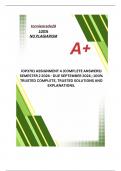,You are a registered psychometrist working at a university counselling centre.
The centre provides a range of psychometric assessment services to support
students facing academic and personal challenges. Recently, there has been
an increase in students seeking help due to stress, anxiety, and uncertainties
about their future careers. You have been tasked with developing a
comprehensive assessment process that incorporates psychometric tools to
better understand these students' needs and provide targeted support. CASE
OVERVIEW: A 21-year-old undergraduate student, Sam, has approached the
counselling centre. Sam is in his third year of studies and reports feeling
overwhelmed with academic pressures, experiencing low motivation, and
struggling with decision-making regarding his future career path. His
academic performance has declined, and he has expressed feelings of
anxiety and low mood. As a psychometrist, your role is to design a tailored
assessment process using various psychometric tools to provide insights into
Sam’s cognitive functioning, well-being and personality traits.
______________________________________________________________
_____________ Student Instructions You are required to complete this
assignment based on the provided case study. The assignment must be
professionally written and well-structured. Please ensure that each question is
clearly indicated and that your responses are directly linked to the case study.
QUESTION 1. Define dynamic assessment and explain how it differs from
traditional assessment methods. In the context of Sam’s academic struggles,
how could you apply dynamic assessment to identify his learning potential? (5
Marks)
Dynamic assessment is a method of evaluating an individual's learning potential by focusing on
their ability to learn when provided with appropriate intervention or support during the
assessment process. Unlike traditional assessment methods, which often involve a one-time test
to measure static abilities (such as IQ or academic performance), dynamic assessment is more
interactive and emphasizes the individual's capacity to improve or change with guidance. It is
based on Vygotsky's concept of the "zone of proximal development," which suggests that
potential learning can be better understood by observing how a person learns when given help,
rather than relying solely on their independent performance.
Key differences between dynamic and traditional assessments include:
, 1. Focus on potential vs. current abilities: Traditional assessments measure existing
abilities, while dynamic assessments explore the potential for learning and development.
2. Interactive vs. non-interactive: Dynamic assessments involve interaction between the
assessor and the student, offering feedback and guidance during the assessment, whereas
traditional assessments are more static and non-interactive.
3. Emphasis on learning processes: Dynamic assessment examines how a student
responds to instruction, highlighting the learning process rather than just outcomes.
4. Formative vs. summative: Dynamic assessment provides formative insights, helping to
inform future educational interventions, while traditional assessments often serve as
summative evaluations of ability.
5. Adaptability: Dynamic assessment is flexible and adjusts to the student's needs in real-
time, while traditional assessments are typically standardized and rigid.
In Sam’s case, dynamic assessment could be applied to understand his learning potential by
evaluating how he responds to targeted interventions aimed at improving his academic skills and
decision-making processes. For example, during a session, Sam could be given problem-solving
tasks related to his academic subjects. The psychometrist could then provide step-by-step
guidance and observe how Sam incorporates the feedback to improve his performance. This
process would help identify any specific learning strategies or cognitive processes that Sam may
need to develop. Through dynamic assessment, the psychometrist could gain a deeper
understanding of Sam’s current struggles and potential for growth, which can be used to create
tailored interventions to support his academic success and future career decision-making.
QUESTION 2. Discuss the principles of positive psychology and how they
can be applied to enhance well-being in individuals like Sam, who is
experiencing academic stress. Discuss PANAS as a measures of well-being
that could be utilised to assess Sam's current state. (5 Marks)
Positive psychology is a branch of psychology that focuses on the strengths, virtues, and factors
that contribute to human flourishing and well-being, rather than just the treatment of mental
illness. It emphasizes building on what is good in life to enhance well-being, resilience, and life
satisfaction. The key principles of positive psychology that can be applied to Sam’s situation
include:
1. Focusing on Strengths: Positive psychology encourages identifying and developing
personal strengths, which can help individuals like Sam feel more competent and
motivated. By recognizing his academic skills or other areas of competence, Sam could
regain confidence in his abilities and improve his overall academic performance.
2. Cultivating Positive Emotions: Positive emotions like joy, gratitude, and hope can
broaden one’s thinking and build resilience. Encouraging Sam to engage in activities that




